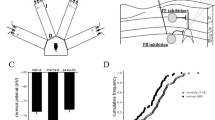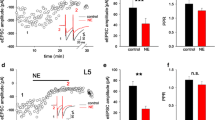Summary
The possible occurrence and role of protein kinase C at the lateral olfactory tract (LOT)-pyramidal cell synapse of the rat olfactory cortex slice has been investigated by determining the effects of both activators (4-β-phorbol-12,13,diacetate [PDAc] and 1,2-dioctanoyl-sn-glycerol) and inhibitors (5-isoquinolinylsulphonyl)-2-methylpiperazine [H-7], sangivamycin and polymyxin B of the enzyme on the surface field potential known as the N-wave. PDAc (0.3 to 20 μmol/l) and 1,2-dioctanoyl-sn-glycerol (25 to 250 μmol/l) increased the area and amplitude of the potential. In control slices in which a population spike was recorded, PDAc also triggered the appearance of multiple spikes. In a series of input-output experiments, PDAc (2.5 or 5 μmol/l) increased the area and amplitude of the N-wave relative to that of the action potential but did not significantly affect pyramidal cell excitability. The effects of PDAc on the N-wave were antagonised by all three protein kinase C inhibitors but not by the calmodulin antagonist calmidazolium and were greater in slices perfused with solution containing 10 rather than 1 mmol/l Mg2+ or 1.25 rather than 5 mmol/l Ca2+. The effect of PDAc on the amplitude but not area of the N-wave was blocked by the potassium channel blocker tetraethylammonium (10 mmol/l) but not by 4-aminopyridine (0.25 mmol/l). In a series of conditioning experiments, PDAc (1 to 5 μmol/l) reduced the amplitude of the N-wave evoked by a second stimulus compared to that evoked by the first conditioning pulse. PDAc also caused a selective, concentration-dependent reduction in the response evoked by Nmethyl-D-aspartate (NMDA), an action blocked by H-7. None of these effects of PDAc was reproduced by 4-\-bphorbol and 4-α-phorbol (10 μmol/l), two analogues of phorbol which do not affect protein kinase C activity. It is concluded that: (i) the effects of PDAc are mediated by activation of protein kinase C; (ii) activation of protein kinase C at the LOT-pyramidal cell synapse potentiates transmission by increasing transmitter release, although an effect of pyramidal cell excitability cannot be ruled out; (iii) protein kinase C may regulate the activity of NMDA receptors.
Similar content being viewed by others
References
Allgaier C, Daschmann B, Huang HY, Hertting G (1988) Protein kinase C and presynaptic modulation of acetylcholine release in rabbit hippocampus. Br J Pharmacol 93:525–534
Anson J, Collins GGS (1987) Possible presynaptic actions of 2-amino-4-phosphonobutyrate in rat olfactory cortex. Br J Pharmacol 91:753 -761
Baraban JM (1987) Phorbol esters: probes of protein kinase C function in the brain. Trends in Neurosci 10:57–58
Bartschat DK, Blaustein MP (1985) Calcium-activated potassium channels in isolated presynaptic nerve terminals from rat brain. J Physiol (Lond) 361:441–457
Berridge MJ (1984) Inositol triphosphate and diacylglycerol as second messengers. Biochem J 220:345–360
Brown DA, Galvan M (1979) Responses of the guinea-pig olfactory cortex slice to γ-aminobutyric acid recorded with extracellular electrodes. Br J Pharmacol 65:347–353
Cain CR, Simmonds MA (1982) GABA-mediated changes in excitability of the rat lateral olfactory tract in vitro. J Physiol (Lond) 332:487–499
Castagna M, Takai Y, Kaibuchi I, Sano K, Kikkawa U, Nishizuka Y (1982) Direct activation of calcium-activated, phospholipid-dependent protein kinase by tumor-promoting phorbol esters. J Biol Chem 257:7847–7851
Colby KA, Blaustein MP (1988) Inhibition of voltage-gated K channels in synaptosomes by sn-1,2-dioctanoylglycerol, an activator of protein kinase C. J Neurosci 8:4685–4692
Collins GGS (1982) Some effects of excitatory amino acid receptor antagonists on synaptic transmission in the rat olfactory cortex slice. Brain Res 244:311–318
Collins GGS (1986) Role of excitatory amino acids in the olfactory system. In: Roberts PJ, Storm-Mathisen J, Bradford HF (eds) Excitatory amino acids. MacMillan, Basingstoke, pp 131–142
Collins GGS (1988) Effects of the anaesthetic 2,6-diisopropylphenol on synaptic transmission in the rat olfactory cortex slice. Br J Pharmacol 95:939–949
Collins GGS, Anson J (1985) Adenosine A1 receptors mediate the inhibitory effects of exogenous adenosine in the rat olfactory cortex slice. Neuropharmacol 24:1077–1084
Collins GGS, Brown G (1986) A quantitative estimate of the contributions made by various receptor categories to the depolarizations evoked by some excitatory amino acids in the olfactory cortex. Brain Res 371:9–16
Collins GGS, Buckley KS (1989) 6,7-Dinitroquinoxyline-2,3-dione (DNQX) blocks monosynaptic excitations in the mouse olfactory cortex. Neuropharmacology 28:1123–1128
Collins GGS, Howlett SJ (1988) The pharmacology of excitatory transmission in the rat olfactory cortex slice. Neuropharmacol 27:697–705
Collins GGS, Richards WJ (1989) 4-\-Phorbol-12,13-diacetate potentiates monosynaptically-evoked excitations in the olfactory cortex. Br J Pharmacol 96:318P
Collins GGS, Surtees L (1986) ‘Desensitization’ of excitatory amino acid responses in the olfactory cortex. Neuropharmacol 25:231–240
Collins GGS, Anson J, Surtees L (1983) Presynaptic kainate and Nmethyl-D-aspartate receptors regulate excitatory amino acid release in the olfactory cortex. Brain Res 265:157–159
De Riemer SA, Greengard P, Kaczmarek LK (1985a) Calcium/phosphatidylserine/diacylglycerol-dependent proteinphosphorylation in the Aplysia nervous system. J Neurosci 5:2672–2676
De Riemer SA, Strong JA, Albert KA, Greengard P, Kaczmarek LK (1985b) Enhancement of calcium current in Aplysia neurones by phorbol ester and protein kinase C. Nature 313: 313–316
Farooqui AA, Farooqui T, Yates AJ, Horrocks LA (1988) Regulation of protein kinase C by various lipids. Neurochem Res 13:499–511
ffrench-Mullen JMH, Koller K, Zaczek R, Coyle JT, Hori N, Carpenter DO (1985) N-acetylaspartylglutamate: possible role as the neurotransmitter of the lateral olfactory tract. Proc Natl Acad Sci USA 82:3897–3900
Gietzen K, Wüthrich A, Bader H (1981) R24571; a new powerful inhibitor of red blood cell Ca2+-transport ATPase and of calmodulin-regulated functions. Biochem Biophys Res Commun 102:418–425
Haberly LB (1985) Neuronal circuitry in olfactory cortex: anatomy and functional implications. Chem Senses 10:219–238
Halliwell JB (1976) Synaptic interaction underlying piriform evoked responses studied in vitro. Exp Brain Res Suppl 1:223–228
Hidaka H, Inagaki M, Kawamoto S, Sasaki Y (1984) Isoquinoline-sulfonamides, novel and potent inhibitors of cyclic nucleotide dependent protein kinase and protein kinase C. Biochemistry 23:5936–5041
Jenkinson DH (1957) The nature of antagonism between calcium and magnesium ions at the neuromuscular junction. J Physiol (Lond) 136:434–444
Kaczmarek LK (1987) The role of protein kinase C in the regulation of ion channels and neurotransmitter release. Trends in Neurosci 10:30–34
Katz B, Miledi R (1968) The role of calcium in neuromuscular facilitation. J Physiol (Lond) 195:482–492
Knaus H-G, Streissnig J, Koza A, Glossmann H (1987) Neurotoxic aminoglycoside antibiotics are potent inhibitors of [125I]-omega-ionotoxin GVIA binding to guinea-pig cortex mem branes. Naunyn-Schmiedeberg's Arch Pharmacol 335:583–586
Linden J, Delahunty TM (1989) Receptors that inhibit phosphoinositide breakdown. Trends in Pharmacol Sci 10:114–120
Llinas R, Walton K, Bohr R (1976) Synaptic transmission in squid giant synapse after potassium conductance blockage with external 3- and 4-aminopyridine. Biophys J 16:83–86
Loomis CR, Bell RM (1988) Sangivamycin, a nucleoside analogue, is a potent inhibitor of protein kinase C. J Biol Chem 263:1682–1692
Malenka RC, Ayoub GS, Nicholl RA (1987) Phorbol esters enhance transmitter release in rat hippocampal slices. Brain Res 403:198–203
Matthies HJG, Palfrey HC, Hirnig LD, Miller RJ (1987) Down regulation of protein kinase C in neuronal cells: effects on neurotransmitter release. J Neurosci 7:1198–1206
Mazzei GJ, Katoh N, Kuo JH (1982) Polymyxin B is a more selective inhibitor for phospholipid-sensitive Ca2+-dependent protein kinase than for calmodulin-sensitive Ca2+-dependent protein kinase. Biochem Biophys Res Commun 109:1129–1133
Motley SJ, Collins GGS (1983) Endogenous adenosine inhibits excitatory transmission in the rat olfactory cortex slice. Neuropharmacol 22:1081–1086
Nichols RA, Haycock JW, Wank JKT, Greengard P (1987) Phorbol ester enhancement of neurotransmitter release from rat brain synaptosomes. J Neurochem 48:615–621
Nicoletti R, Iadorola MJ, Worblewski JT, Costa E (1986) Excitatory amino acid recognition sites coupled with phospholipid metabolism; developmental changes and interactions with a1adrenoceptors. Proc Natl Acad Sci USA 83:1931–1935
Nishizuka Y (1984a) The role protein kinase C in cell surface signal transduction and tumor promotion. Nature 308:693–698
Nishizuka Y (1984b) Turnover of inositol phospholipids and signal transduction. Science 225:1365–1370
Nishizuka Y (1986) Studies and perspectives of protein kinase C. Science 233:305–312
Peralta EG, Ashkenazi A, Winslow JW, Ramachadran J, Capon DJ (1988) Differential regulation of PI hydrolysis and adenyl cyclase by muscarinic receptor subtypes. Nature 334:434–437
Pickles HG, Simmonds MA (1976) Possible presynaptic inhibition in rat olfactory cortex. J Physiol (Lond) 260:475–486
Racine R, Milgram NM (1983) Short-term Potentiation phenomena in rat limbic forebrain. Brain Res 26:201–216
Richards CD (1972) Potentiation and depression of synaptic transmission in the olfactory cortex of the guinea-pig. J Physiol (Lond) 222:209–231
Richards CD, Sercombe R (1968) Electrical activity observed in guinea-pig olfactory cortex maintained in vitro. J Physiol (Lond) 197:667–683
Routtenberg A (1985) Protein kinase C activation leading to protein F1 phosphorylation may regulate synaptic plasticity by presynaptic terminal growth. Behav Neurol Biol 44:186–200
Schmidt BH, Weiss S, Sebben M, Kemp DE, Bockaert J, Sladeczek F (1987) Dual action of excitatory amino acids on the metabolism of inositol phosphates in striatal neurons. Mol Pharmacol 32:364–368
Schoepp DD, Johnson BG (1988) Excitatory amino acid agonist-antagonist interactions at 2-amino-4-phosphonobutyric acid-sensitive quisqualate receptors coupled to phosphoinositide hydrolysis in slices of rat hippocampus. J Neurochem 50:1605–1613
Scott JW, McBride RL, Schneider SP (1980) The organization of projections from the olfactory bulb to piriform cortex and olfactory tubercle in the rat. J Comp Neurol 194: 519–534
Stanfield PR (1983) Tetraethylammonium ions and the potassium permeability of excitable cells. Rev Physiol Biochem Pharmacol 97:1–67
Storm JF (1987) Phorbol esters broaden the action potential in CA1 hippocampal pyramidal cells. Neurosci Lett 75:71–74
Sugiyama H, Ito I, Hirono C (1987) A new type of glutamate receptor linked to inositol phospholipid metabolism. Nature 325:531–533
Wang H-Y, Friedman E (1987) Protein kinase C: regulation of serotonin release from rat brain cortical slices. Eur J Pharmacol 141:15–21
Watkins JC, Evans RH (1981) Excitatory amino acid neurotransmitters. Ann Rev Pharmacol Toxicol 21:165–204
Williams SH, Constanti A (1988) A quantitative study of the effects of some muscarinic antagonists on the guinea-pig olfactory cortex slice. Br J Pharmacol 93:855–862
Zurgil N, Zisapel N (1985) Phorbol ester and calcium act synergistically to enhance neurotransmitter release by brain neurons in culture. FEBS Lett 185:257–261
Author information
Authors and Affiliations
Additional information
Send offprint requests to G. G. S. Collins at the above address
Rights and permissions
About this article
Cite this article
Collins, G.G.S., Richards, W.J. Pharmacological evidence that protein kinase C modulates monosynaptic excitations in the olfactory cortex. Naunyn-Schmiedeberg's Arch Pharmacol 341, 114–122 (1990). https://doi.org/10.1007/BF00195067
Received:
Accepted:
Issue Date:
DOI: https://doi.org/10.1007/BF00195067




